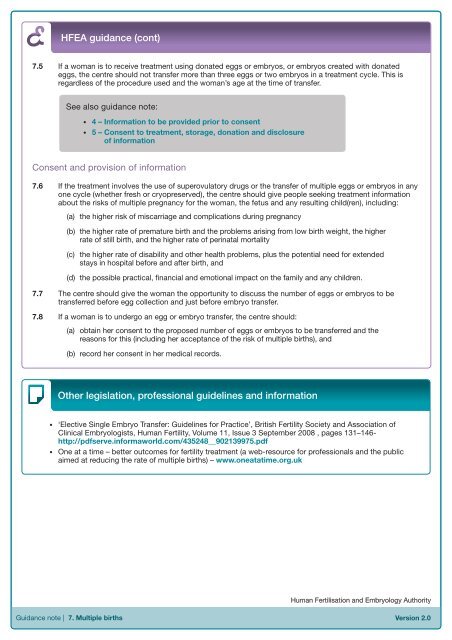Eighth Edition - R.3 - Human Fertilisation & Embryology Authority
Eighth Edition - R.3 - Human Fertilisation & Embryology Authority
Eighth Edition - R.3 - Human Fertilisation & Embryology Authority
You also want an ePaper? Increase the reach of your titles
YUMPU automatically turns print PDFs into web optimized ePapers that Google loves.
HFEA guidance (cont)<br />
7.5 If a woman is to receive treatment using donated eggs or embryos, or embryos created with donated<br />
eggs, the centre should not transfer more than three eggs or two embryos in a treatment cycle. This is<br />
regardless of the procedure used and the woman’s age at the time of transfer.<br />
See also guidance note:<br />
<br />
<br />
4 – Information to be provided prior to consent<br />
5 – Consent to treatment, storage, donation and disclosure<br />
of information<br />
Consent and provision of information<br />
7.6 If the treatment involves the use of superovulatory drugs or the transfer of multiple eggs or embryos in any<br />
one cycle (whether fresh or cryopreserved), the centre should give people seeking treatment information<br />
about the risks of multiple pregnancy for the woman, the fetus and any resulting child(ren), including:<br />
(a)<br />
the higher risk of miscarriage and complications during pregnancy<br />
(b)<br />
(c)<br />
(d)<br />
the higher rate of premature birth and the problems arising from low birth weight, the higher<br />
rate of still birth, and the higher rate of perinatal mortality<br />
the higher rate of disability and other health problems, plus the potential need for extended<br />
stays in hospital before and after birth, and<br />
the possible practical, financial and emotional impact on the family and any children.<br />
7.7 The centre should give the woman the opportunity to discuss the number of eggs or embryos to be<br />
transferred before egg collection and just before embryo transfer.<br />
7.8 If a woman is to undergo an egg or embryo transfer, the centre should:<br />
(a) obtain her consent to the proposed number of eggs or embryos to be transferred and the<br />
reasons for this (including her acceptance of the risk of multiple births), and<br />
(b)<br />
record her consent in her medical records.<br />
Other legislation, professional guidelines and information<br />
‘Elective Single Embryo Transfer: Guidelines for Practice’, British Fertility Society and Association of<br />
Clinical Embryologists, <strong>Human</strong> Fertility, Volume 11, Issue 3 September 2008 , pages 131–146-<br />
http://pdfserve.informaworld.com/435248__902139975.pdf<br />
One at a time – better outcomes for fertility treatment (a web-resource for professionals and the public<br />
aimed at reducing the rate of multiple births) – www.oneatatime.org.uk<br />
<strong>Human</strong> <strong>Fertilisation</strong> and <strong>Embryology</strong> <strong>Authority</strong><br />
Guidance note | 7. Multiple births<br />
Version 2.0<br />
1.0

















